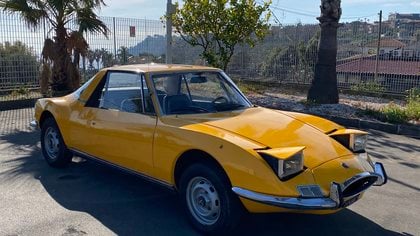Description
Price on request
Very special Matra djet from '66 with a Gordini Engine!
Exterior:
Still new paint, no other flaws or stains on the car either.
Interior:
As you can see on the pictures, the interior has no tears or any flaws. You can always call or mail if you want more pictures.
Mechanics:
Cal for more information about the Gordini engine.
History:
The car started out as the René Bonnet Djet in June 1962. This model became known in retrospect as the Djet I. The car was named "Djet" because Bonnet thought the French would not pronounce the word "jet" correctly. It was powered by a 65 PS (48 kW) 1, 108 cc engine from a Renault 8 in a mid-engine location mated to a gearbox from the Renault Estafette van.[2] This power-train gave the car a top speed of 165 km/ h (103 mph), or 190 km/ h (118 mph) in the later Djet III with a Gordini engine. A fiberglass body was chosen for its lightness, ease of repairs, and to keep initial investment costs low.[3] The body was made by Matra's Générale d'Applications Plastiques subsidiary in Romorantin, and was bonded directly to a steel chassis. The chassis were built in Bonnet's factory in Champigny-sur-Marne (a Paris suburb), where final assembly also took place.[3]
As part of Bonnet's contract with Renault, the Djet was developed to be able to compete in several different classes, but in the end only 1000 and 1100 cc models were made.[4] The competition Aérodjet of 1963 (pictured in the gallery) came with special long-tailed bodywork and bigger fenders to accommodate wider wheels. The name is often styled "D'jet" or "D'Jet".
The Djet's suspension was quite advanced for the time, being a fully independent system having upper and lower A-arms with coil springs and disc brakes at all four wheels. The car accommodated just two people, as the engine took the space where a rear seat would otherwise be. The Djet I was 3, 800 mm (149. 6 in) long by 1, 400 mm (55. 1 in) wide by 1, 150 mm (45. 3 in) high and weighed only 600 kg (1, 323 lb). Announced in 1962, the Bonnet Djet was the world's first mid-engined production road car, beating the De Tomaso Vallelunga which was introduced in 1963, even though the first production Djets did not leave the factory until July 1963.[5] During the two years before Matra took over, 198 Bonnet Djets were produced, with all but 19 being built to the lower-powered Djet I specification. After becoming the Matra Djet in 1964 a further 1, 491 cars were produced before production ended in 1968.[5] Fewer than 60 Vallelungas were built before De Tomaso replaced it with the Mangusta in 1967.
The Djet was priced at 20, 000 French francs at launch, the same as its much larger and more luxurious contemporary, the Facel-Vega Facellia.[5] The Bonnet did not impress by its level of finish, and the unisolated fibreglass bodywork made for an extremely noisy environment inside.[6] Bonnet believed that the competition record of the Djet and his company would be enough to convince the public to purchase the Djet, but this would prove not to be the case.
When Bonnet got into financial troubles, Matra, who already supplied both the bodyshells and the factory for the Djet, took over René Bonnet Automobiles and its debts in October 1964.[2][7] Production of the original Djet was stopped in December 1964. Matra's President Marcel Chassagny considered this a great opportunity for Matra to expand into the automobile market. Chassagny hired Jean-Luc Lagardère away from aeronautics competitors Avions Marcel Dassault to run the newly formed Matra Sports and Engins Matra divisions.[8] Former Simca designer Philippe Guédon was hired to modify the original Bonnet Djet. The car became slightly bigger, measuring 4, 220 mm (166. 1 in) long by 1, 500 mm (59. 1 in) wide by 1, 200 mm (47. 2 in) high and weighing 660 kg (1, 455 lb). Production resumed in April 1965 with two new versions; the Matra-Bonnet Djet V and the Djet V S, the latter having a Gordini-tuned engine.
During his 1965 tour of France, Yuri Gagarin was presented with a Matra-Bonnet Djet V S coupé by the French government.[2] The car was later photographed wearing Soviet license plates.[9] Production was gradually moved away from the old Bonnet plant, and late Jets were built entirely at Matra's home plant in Romorantins.[10]
After the Paris Motor Show in 1965, the Roman numerals and the Bonnet name were dropped. The car was now called the Matra








